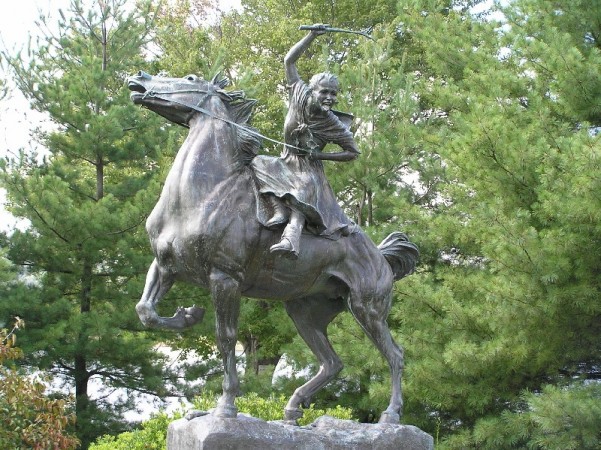Hartford Circus Fire Remembered; Then On To Anna Hyatt Huntington
One day.
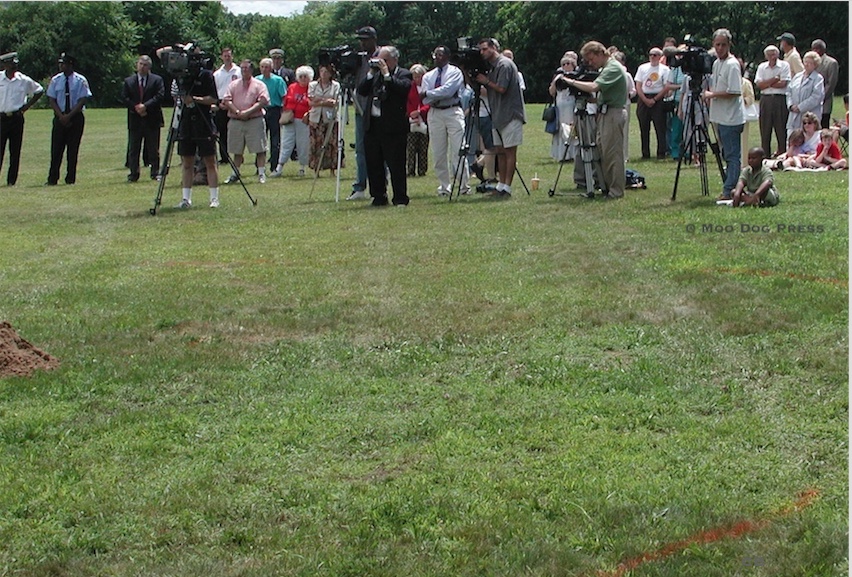
July 6, 2004, groundbreaking of what would become the Hartford Circus Fire Memorial behind Wish School in Hartford — on site where this tragedy happened in 1944.
The image above is from the dedication of the Hartford Circus Fire Memorial on the site where this terrible event happened. By turning around saw some who stood outside the footprint of the circus tent and crowds gathered. Have always wondered if modern-day technology could reconstruct the unknown little girl's face from a photograph, do so in 3-D modeling on a computer, then make a physical model sculpted by a forensic artist. That a documentary could show the process, and confirm her identity as Eleanor Cook or open the questioning based on what she actually looked like in life. The best book (personal opinion as a passionate reader) is The Circus Fire by Stewart O'Nan; the author raises the question of identification based on evidence and dental records. He also writes about the human condition, that some saw the fire beginning and simply did not react in response to danger approaching. Others did see the threat, assessed, responded, acted. Insight that applies in every disaster, natural or otherwise. A pandemic, for instance.
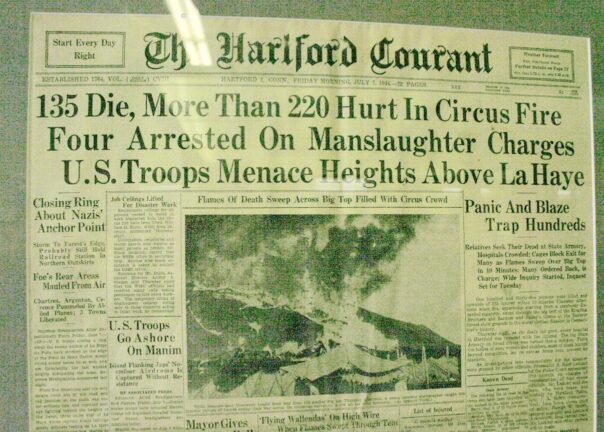
Framed and on display in another location — The Hartford Courant's front page on the morning of July 7, 1944.
Back to Hartford on the day of the groundbreaking for the memorial. Paging through the digital images (many not ever published), noting some of those in the images aren't here anymore. Speakers, members of the audience gathered, media. Also that technologies have changed — broadcast-quality videos can be made on an iPhone, which is a handheld computer. In 2004 a digital camera was often underestimated. The Nikon that captured the images had a custom grip that proved helpful that oppressively hot day. And, yes the camera was retired to its place of honor beside other equipment that served as workhorses.

One man stands outside the outline of where the circus tent was; at the groundbreaking for the Hartford Circus Fire memorial, from the archives. Photo by Chris Brunson
A memory, from someone who was there that day as a boy, Charles Nelson Reilly. July 6, 1944. (He's gone now, but his story stands.)
“While he was still a child, however, he and a friend attended to the ill-fated Ringling Bros show of July 6, 1944 that turned into one of the worst human disasters in Connecticut history….” For more, read Today in Connecticut History about Reilly on his birthdate.
Or view a portion of The Life of Reilly, Hartford Circus Fire (2010).
“In this segment Charles explains a traumatizing moment from his childhood, as he recalls the day he witnessed a circus tent burn to the ground.”
A writer is an entrepreneur and a hunter. Resourceful. Enterprising. Able to pivot and find ideas, create a story to open a window in a world of science, business, medicine, history, lives lived. To start with a blank page or screen and put words together to bring light, truth, story into being.
From the press release (edited): “The Hartford Circus Fire Memorial Foundation will commemorate the 60th anniversary of the tragic Hartford Circus Fire in a groundbreaking ceremony for a memorial to the victims and survivors of the Hartford Circus Fire on Tuesday, July 6, 2004, at 2 p.m. behind the Wish School, located at 350 Barbour Street, Hartford.
“Invited guests speakers, survivors and members of the Hartford Circus Fire Memorial Foundation Committee will share reflections of this tragedy and their vision for the future. …
“Fundraising for the memorial began in February of 2003. Since then, more than $100,000 thousand dollars in private and public funding has been raised for the memorial by the Hartford Circus Fire Memorial Foundation.” — link to the original source
It's a good thing we are all different with varying degrees of ability and talents.
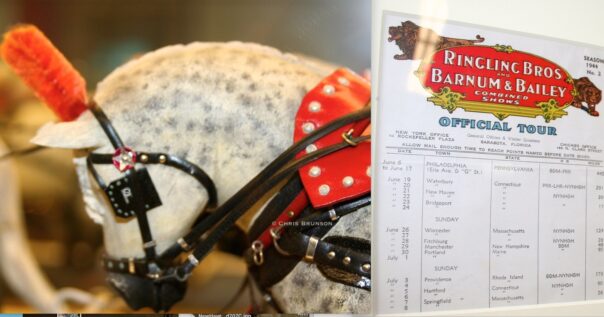
From an exhibit in surprising location, 2015. And the original schedule for 1944 including mileage and locations for the circus.
Let's turn the page and visit another place that serves as a memorial and an artist who studied life and movement of horses and animals at circuses among other places.
Artist Anna Hyatt Huntington was in her 90s when she created the equestrian statue that depicts the legendary ride of General Israel Putnam who made his escape from pursuing British Dragoons at Horses Neck (now Greenwich) Connecticut, in February 1779. For why he's shaking his fist and how many steps he rode, a lively account is linked here. Located at the entrance to Putnam Memorial State Park in Connecticut, the artwork is a worthy salute to Putnam and the men who lived on the site during an encampment in winter 1778 to spring of 1779.
Thrown out of an art class by her first teacher for pointing out errors in equine anatomy of his work, Hyatt studied animals from life, at circuses, in zoos. Her iconic work includes the equestrian statue of Joan of Arc and the Fighting Stallions and a soulful Don Quixote. She also called forth Abe Lincoln, El Cid, Great Danes, wolves, dogs a mother bear with cubs, and powerful panthers.
An insightful interview with Anna Hyatt-Huntington (in the public domain) conducted by Dorothy Seckler for the Archives of American Art in 1964 is a gem tucked away inside an archive at the Smithsonian Institution.
Seckler: Well, to come back to my animals, I don't know why this list is eluding me here . . . . I was working on it this morning before coming up. According to Mrs. Prosky there is a feeling that one of the most recurring ideas in your work is the sense of struggle between instinct and, well, the controlling factor of reason. Is that anything conscious?
Hyatt-Huntington: I'm not intellectual enough.
DS: Well, you wouldn't formulate it to yourself then?
AH: No, somebody might interpret that way but I don't think I ever have any profound reasoning in anything I do. It is only interesting for the nature of the animals and the action and that's all. That's all I go by. . . . I think it's all in knowing your animal and knowing how they act and being able to sort of feel it to yourself.
…
DS: I was interested very much in the story about the young Lettington girl and her work as a revolutionary rivaling the role of Paul Revere.
AH: Yes. The Paul Revere which was in '76 and I think she was in '77 and it was at the time when the British were burning Danbury and they were going through to burn the stores at West Point and her father was stationed on that route; he was in Carmel, near Brewster, New York. He was the colonel of a regiment and his regiment, as in those days, lived in the country in scattered houses and farms and that sort of thing, and it was during the night that he got the message from Danbury that the British were coming through and he said to his daughter, “I can't leave and there is no one else here.” They were in the house there alone and he said, “Will you go on one of the horses and alert my troops? You know where they live.”
So she jumped on the horse; she was a good rider and off she tore to the different houses and she had to ride probably 30 miles from one house to another that night and she managed to alert all the troops so that before daylight they were all gathered at his house. From there they went, the small regiment of them, to Ridgefield where they know that the British were coming.
And at that time, fortunately for this small troop, the British had found a large store of liquor in Danbury so that the British had drunk a good deal of whiskey before they got on the road. So by the time they reached Ridgefield, they were in no condition to form and fight the Colonial troops that met them and so they were defeated there on the road and had to go back to Westport and it stopped their main drive. So General Washington thought that her mission, riding that night to alert the troops, was a very important thing and he came way up from Washington to congratulate her.
DS: And her name was Sybil.
AH: Sybil Lettington. And she is not mentioned unfortunately in American history.”
The interview continues as the artist mentions her work ethic.
AH: Oh, yes. I've always, in fact from the very early days when I was working down at the farm — I always had to get up early when I got up to milk my own cows, clean stables, doing all that sort of thing. So it's been for many, many years I've been following that regime. Only today I don't happen to have . . . I have cows to milk, but I don't do it myself.
DS: Do you have cows?
AH: Yes, we keep a little barn.
DS: What other animals do you have here?
AH: Oh, chickens, we have some old horses; they are just eating at pasture now, that sort of thing.
DS: You can't use them very much for models now I suppose, or do you?
AH: I could if I wanted to do an old horse. A Quixote horse or something of that sort. I had a real sample of that sort of thing down south when I did the Rosanante, that was a real bony horse.
DS: You really had a model?
AH: I really had a model that was just about on his last legs, as it were, but I had to work very quickly because naturally when you get a horse of that type in your stable, you have to feed him and you want to feed him and he's very hungry so that within a month he was quite a different-looking horse and so I had to work very quickly to get the original Rosanante.
DS: I'm sure I would end up by fattening him up too.
AH: You couldn't help but do it.
DS: No, I certainly couldn't.
End of interview.
Two of her works – a mother bear with her cubs and two wolves howling – flank the entrance to 883-acre Collis P. Huntington State Park, a gift from the Huntingtons to the state.
The statue may be seen at Israel Putnam Memorial State Park, the former encampment site, designated as Connecticut's first State Archaeological Preserve. A visitors center offers exhibits and donated objects that tell the story of some 3,000 men whose mission was to guard storehouses in Danbury and protect Long Island Sound and the Hudson River Valley. The Friends and Neighbors (FAN) site includes detailed history, more about artifacts and a map.
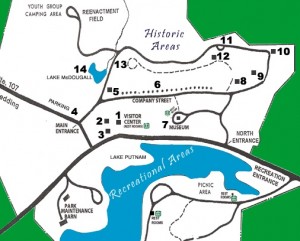
From Friends and Neighbors of Putnam Park: “The enlisted men's encampment consisted of 116 log huts set in a double row for almost a quarter mile down the company street. The only above ground remains of those huts today are the piles of collapsed stone chimneys. Each stone pile, or fireback, marks the location of a 1778 hut.”
Park trails range from easy to strenuous; located at the intersection of Route 107 and Route 58 in Redding. Be sure to check yourself and companions for ticks when leaving.


